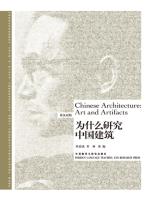Significance of Studying and P
Chinese architecture has been one of the most resplendent pearls of ancient Chinese art, and Mr. Liang’s book may be the unprecedented work that introduces this cultural treasure to contemporary Chinese citizens as well as the world systematically, leading readers to a world of the magnificent crystallization of ancient Chinese wisdom expressed in this frozen form of art.
Well-knit in structure and vivid in description, Chinese Architecture Art and Artifacts is of high literary value. In the strict sense, translated and edited by other scholars, the book is a collection of Mr. Liang’s long-term’s study, questing after architecture of representativeness from a common Han terracotta model, to the grand Liao temple of Tu-lo Ssu. Almost without a single detail being omitted, the essays depict the exquisite design and appropriate arrangement of the architectural structure, through which readers can have an intimate experience of visiting the buildings or even the dynasty when the architecture rose as if in person. The unique structure of dougong, the delicate overhanging eaves, the impressive mural paintings, and the lifelike sculptures, all the splendours make up the literary feast.
Apart from introducing the typical structure and the architectural characteristic of respective period, Mr. Liang also offered abundant cultural background knowledge related to the dynasty of the building, such as the phenomenon of burying someone alive or yong (a kind of human figure) with the dead when introducing the terracotta model buried with the dead, providing readers with an amazing reading experience by stirring their imagination. Moreover, with the fine sketches portrayed by the author as well as the beautiful photographs illustrated in the book, readers can have a better knowledge of the structure combining the abstract words and the representational pictures. To sum up, Chinese Architecture Art and Artifacts is a professional and readable science-popularizing reading worth savouring, explaining the profound architectural theory in an explicit and understandable approach.
As a popular science book, the cultural influence of Chinese Architecture Art and Artifacts is also not to be overlooked. With the impact of foreign culture growing profound, the aesthetic standards of our fellow countrymen get involved in transition inevitably, which indirectly results in the decline of conventional Chinese architecture. This great architectural art worth of national sense of pride is hitherto unknown to some people, and worse still, some others treat them like dirt. The ancient mystical land where magnificent and well-designed historical landmark that used to stand erect throughout the endless flow of history, is now congested with “bean dregs projects” of poor bearing capacity and monotonous glass curtain wall which make no contribution to dwelling atmosphere or the so-called city appearance except for light pollution. Such phenomenon has become commonplace and quite a few scholars of insight voice their lament for the traditional treasure on the wane, one of whom is Ssu-ch’eng Liang. He believed that public awareness for protecting these precious cultural relics should be awakened [1], so he devoted a lifetime to studying traditional Chinese architecture, which was considered “anti-the-trend-of-the-times” work at that time.
Interestingly enough, the Chinese translation of the title of this book is “Why We Study Chinese Architecture Art and Artifacts”. With this question left unanswered, all the appeals for ancient architecture protection appear meaningless, but the book itself gives me few direct answers. What is the significance of studying these “antediluvian” leftovers? In reality, they are not national burden but national gems. If you read the book as careful as me, you can easily understand the craftsmanship and wisdom of our ancestors: keeping warmth in winter and coolness in summer using just different colour of the roofs and walls; planning all the buildings in symmetry according to maximum convenience... Introducing the superiority of these antiquities to our compatriots is an act of inheriting as well as rescuing. With the popularization of the knowledge of Chinese architecture artifacts, architects of the new generation will have a better taste and greater creativity, and the public awareness of protecting will be aroused, and thus more effective measures will be adopted to preserve the cultural heritage. Moreover, introducing them to the world is an important means of cultural “going out”, making the mystery accessible to all human race, and perhaps the tragedy of burning Yuanming Garden to ground will no longer happen again. This is the soft force for architectural preservation.
Imbued with sense of pride between the lines, I understand Mr. Liang’s expectation of architecture renaissance, and most importantly, national renaissance. From where I stand, ancient architecture artifacts are the blood-and-soul part of our civilization. Studying and protecting these national gems is in the interest of the nation, contributing to national rejuvenation, while ignoring and spoiling them betray national spirit. It is exceedingly pitiable and ridiculous if most people of a nation fail to inherit their national culture critically. Mr. Liang’s book is a powerful propagation that arouses our sense of pride and indirectly helps us escape the iceberg of architectural decline, and the one hiding behind the former, of national decline.
As early as 18th century, Victor Hugo had voiced his lament for the architectural decline in his famous novel Notre-Dame de Paris: “Printing will destroy buildings.[2]” Today, will GDP destroy ancient buildings in the country of a profound history? Mr. Liang and scholars as him evert themselves from avoiding this tragedy through their industrious work. And as a reader amazed by the great achievements and wisdom of our ancestors, I earnestly hope that the readable and profound book should be required reading for people of all ranks and classes of our nation. If possible, let us whet the ardour of the whole nation, with which we shall cherish the national architecture!
References:
1. 梁思成.为什么研究中国建筑[DB/OL].
http://www.21ccom.net/articles/dlpl/whpl/2012/0530/60808.html, 1986-09/2012-05-31
2. 维克多·雨果. 巴黎圣母院[M]. 管震湖. 上海: 上海译文出版社, 2011: 179-193



 京公网安备 11010802032529号
京公网安备 11010802032529号